Small rotary mower used to mow close to trunks
Mowers - Tractors - Sprayers - Apple Transport & Harvest Equipment - Site Preparation Equipment - Tree Planting & Trellis Building Equipment - Mulch Spreader - Fertilizer Spreader - Pruning Equipment
There are two types of mowers used in apple orchards: rotary mowers and flail mowers. Rotary mowers are useful to mow the ground cover close to the tree trunks and often are wider than flail mowers so more ground can be covered with a single pass. However, rotary mowers do not chop up prunings or leaf litter like flail mowers, which is a key practice performed in organic IPM to reduce disease inoculum. Rotary mowers usually require less tractor horsepower than flail mowers.
Small rotary mower
used to mow close to trunks
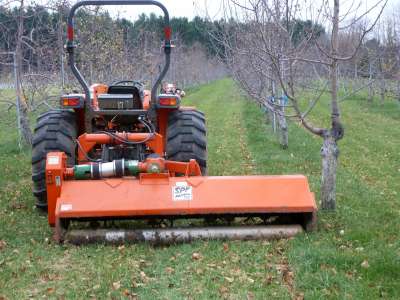
Off-set flail mower used to chop up overwintered leaves and winter prunings
Flail mowers use a horizontally-mounted spinning drum on which knives are mounted that shred materials during operation. This action is important in orchard sanitation, as leaf litter, dropped fruit, and prunings can be finely chopped to allow for biological degradation in the field. This can potentially reduce overwintering levels of apple scab inoculum and spotted tentiform leafminers, as well as recycle nutrients from orchard debris. Flail mowers tend to have higher horsepower requirements than rotary mowers and can be narrower, thus requiring more passes through the orchard. Some flail mowers include hydraulically operated sweepers that push debris in the tree row into the mower path for better coverage. Many are also offset to extend under the dripline of the trees, with some including a hydraulically operated offset to adjust to differing tree row widths.
When deciding what tractor(s) best fits the orchard's needs, the grower should take into consideration the horsepower requirements for orchard mowers and sprayers. There are three types of tractors necessary for orchard management, however, one tractor may span two or more of these types. First, a spray tractor is required. In organic apple production spraying fungicides and insecticides is essential for quality fruit and the proper equipment ensures safe and effective application.
A spray tractor should have high horsepower, a cab to protect the driver from pesticide exposure, and be narrow enough for the tree planting. A spray tractor requires a 45-75 PTO horsepower in order to power an airblast sprayer.
A second general purpose tractor for mowing should be narrow and not have a cab so it can drive as close to the trees as possible. This tractor does not need as much horsepower as the spray tractor, except when flail mowing when high horsepower may be required. A general purpose tractor must have a PTO to power the mower, rototiller, or other attachments necessary. Remote hydraulic outlets are also important for many implements that use cylinders or hydraulic motors for adjustment of operation.
A third tractor with a bucket is necessary if loading mulch and other materials is going to be a frequent occurrence in the orchard.
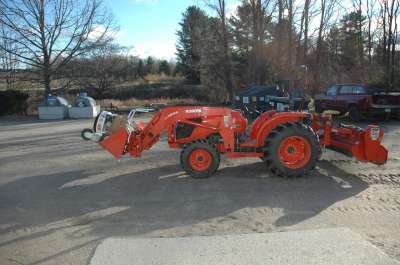
An example of a general
purpose high horsepower tractor with detachable bucket
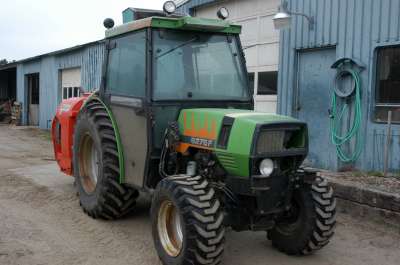
An example of a spray tractor with enclosed cab
There are different types of sprayers available depending on the size of the orchard and the size of the trees. A backpack sprayer can be useful on a small scale when trees are short and easy to reach. A hydraulic handgun sprayer that uses pumped water rather than air is useful to reach the tops of tall trees with spray materials. The sprayer must provide and maintain high pressure and sufficient flow of liquid so that the large droplets of the stream can reach the tops of the trees. Handgun sprayers are adaptable for different small fruit crops and may be the best choice for a diversified farm. A versatile hydraulic handgun sprayer can attach to the three-point hitch of the tractor and may carry 50 or 100 gallons of spray material. These sprayers require relatively little horsepower to operate, but the weight of the filled tank on the three-point hitch can lead to instability of the tractor in some situations.
An airblast sprayer is most commonly used in commercial apple orchards because it is more time-efficient and it uses less water than a handgun sprayer. An airblast sprayer broadcasts small droplets of concentrated pesticide mixture into the tree and therefore measures must be taken to minimize drift when using an airblast sprayer. Properly calibrated airblast sprayers can spray an area in less time and with more uniform coverage than a handgun sprayer, but they require more horsepower than a handgun sprayer to operate.
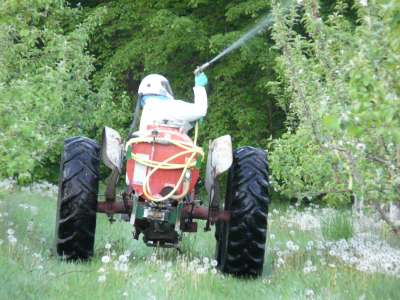
Hydraulic handgun sprayer
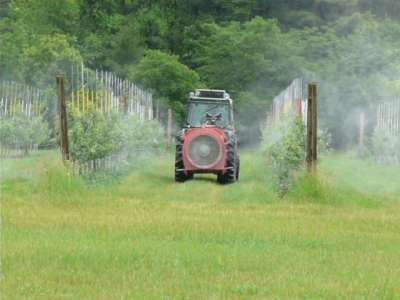
Airblast sprayer
Once the apples are picked (usually requiring picking buckets, ladders, and boxes or bins to load with apples) equipment is needed to transport the full boxes or bins back to the storage facility. If bushel boxes are used, a simple wagon pulled by a utility vehicle can suffice. However, on a large scale commercial orchard bins ranging in size from 12-20 bushels are filled with apples in the field and equipment such as a bin trailer or bin jack is necessary to transport the apples to the storage facility. Filled apple bins can weigh up to 800 pounds, so a forklift, either tractor operated or a separate, dedicated machine, must be used to move them in the field and in the loading/storage area. Electric or propane-powered forklifts are available for use indoors where fumes from gas or diesel engines would be dangerous. (Note: If the farm also has non-certified fruit, that fruit must be harvested into separate bins or boxes than the organically certified fruit. Those boxes/bins must be labeled as such and always kept separate to ensure non-approved materials do not get transferred to the organically certified apples.)
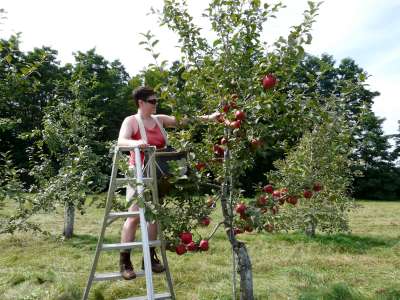
Harvesting apples using
a ladder and picking bucket
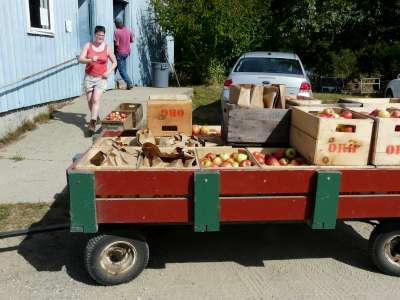
Wagon used to transport harvested fruit to the loading dock
In a commercial operation where apples are stored, a cooler or refrigerated truck/trailer is required to keep your produce cool and increase its shelf life. Organically certified apples must be stored separately from non-certified fruit. They can be in the same cooler, but in separate areas, and the storage must meet the conditions of the certifying agency.
In addition, an area suitable for loading/unloading apple boxes and bins is important to the efficiency of a commercial apple orchard. This area can also serve as a receiving dock for other heavy materials such as trellis posts or fertilizers.
Site preparation is not something that is performed every year and therefore it might be more cost effective to rent the equipment necessary from a vendor or a grower nearby who owns what is needed. Another option is to hire out the job of prepping the site for a future orchard to an operation with experience and suitable equipment. Unlike the specialized equipment used in fruit production, site preparation uses equipment common to dairy farms or field crop operations. Preparing a fallow field or an existing orchard for a new planting of organic apples can involve many different tools.
Tree planting and trellis building also require a few pieces of equipment that can be rented or leased from a vendor or grower. A tree planter can be very time efficient when planting a high density orchard. Tractor-pulled tree planters open a furrow in which an operator places a tree at a marked spot, then closes the furrow during one pass. If a tree planter is not used at planting time and individual holes are made for each tree, an auger would be used to drill the holes.
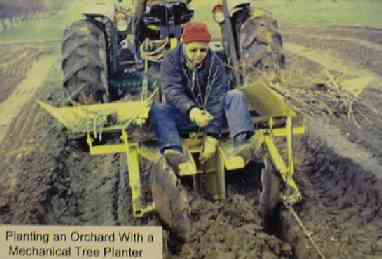
Tractor-pulled tree planter (http://agbioresearch.msu.edu/nwmihort/Confoste.htm)
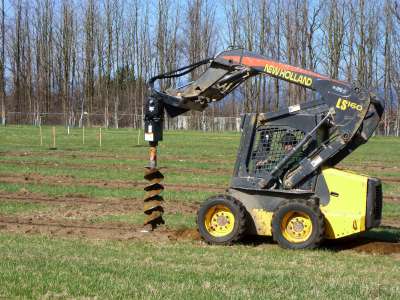
Skid steer-mounted hydraulic auger with 18" diameter bit
Once the trees are planted in a high density orchard, the trellis must be built for support. Building a trellis requires a post pounder, which can also be rented, as well as wire running, cutting and crimping equipment.
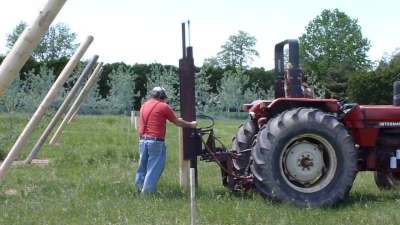
A hydraulic post pounder
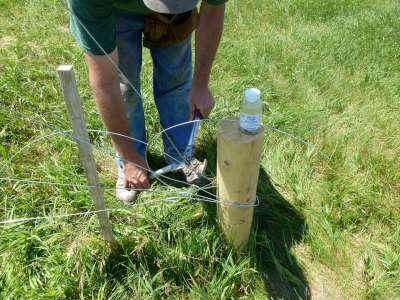
Crimp sleeves and wire
crimper/stripper/cutter are used to fasten the tensioned trellis wire
A mulch spreader can be used in organic apple production to reapply mulch about every two years, but also can be used to apply compost. A tractor-pulled, PTO driven, automated side delivery mulch wagon is time efficient and and practical when running a commercial organic apple orchard.
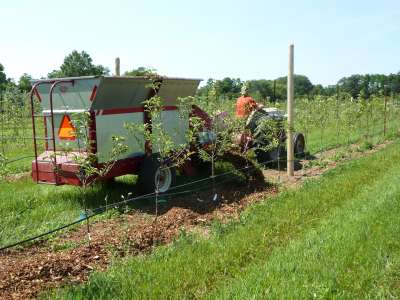
Tractor-pulled side delivery
mulch spreader
Fertilizer will most likely have to be applied every year to organic apple orchards, in addition to soil amendments necessary during site preparation. Depending on the scale of the orchard a fertilizer spreader may be needed to mechanize the task of fertilizing trees.
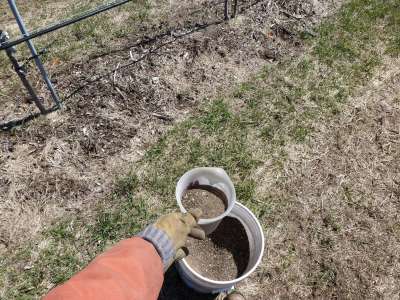
It takes a significant
amount of time to fertilize the trees by hand

An example of a PTO-driven
fertilizer spreader (http://www.extension.iastate.edu/Wine/Resources/winegrowernews119.htm)
Dormant pruning and summer pruning both require equipment such as hand-held clippers, loppers, saws, pole pruners, pole saws, and a power pruner. There are three different types of power pruners: engine driven, hydraulic driven, and electric. The grower can decide what type best suits his/her needs in the orchard.
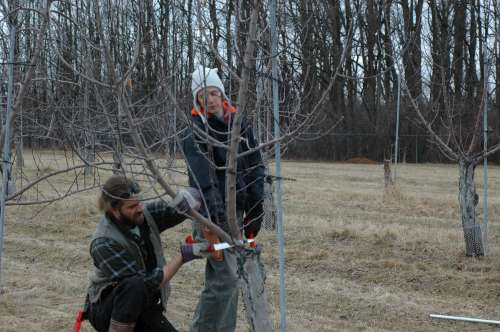
Hand saw used to prune
larger braches
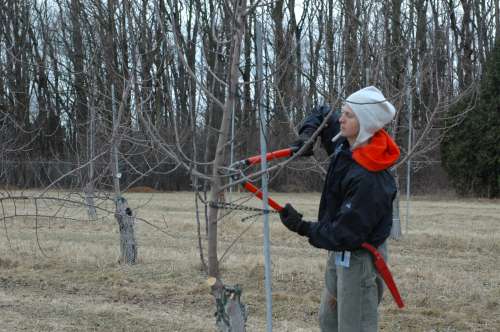
Loppers used to prune shoots
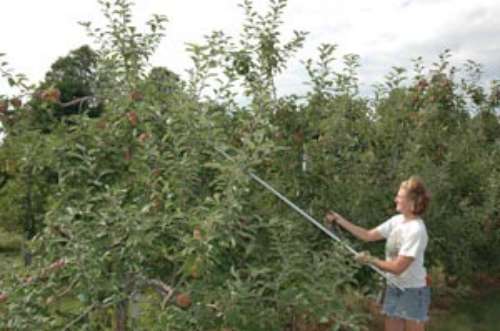
Pole pruner used to
reach shoots at the tops of trees
For more information: